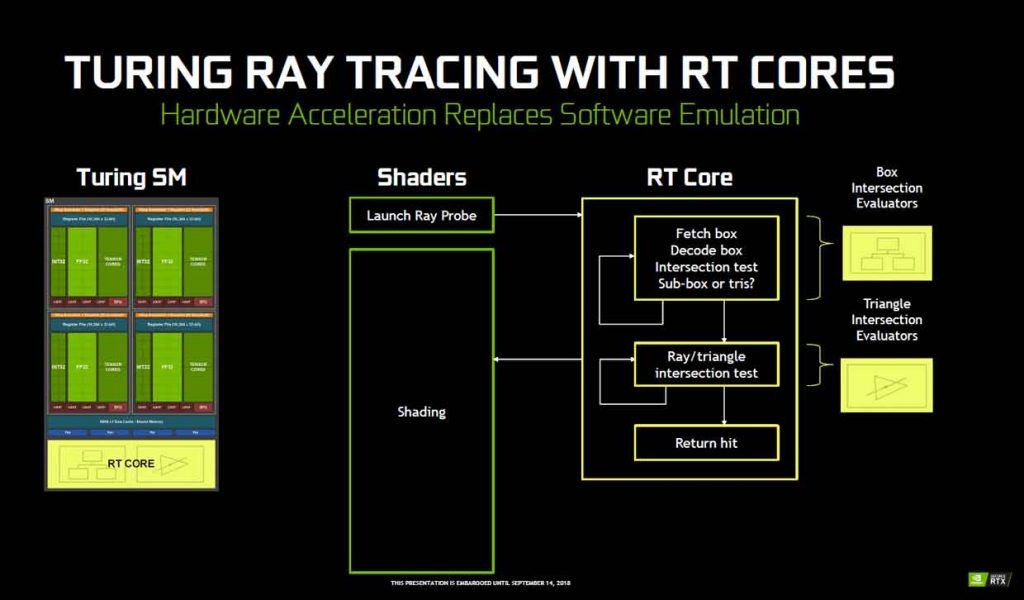With the introduction of the GeForce RTX 20 series, Nvidia introduces a new graphics processor architecture called Turing. It brings important improvements over Pascal (GeForce GTX 1000 series) but is still not completely known. Nvidia is developing Volta, which was launched last year to address the gaming market.
Before seeing its big progress, Turing physically stands out from Pascal with much bigger GPUs. At this point, Nvidia announces an area of 754 mm² for the most powerful version, a good advance over the GP102 of the GTX 1080 Ti and its 471 mm². This GPU, named TU102, is the heart of the showcase of this new generation for the GeForce RTX 2080 Ti.
The expansion makes it possible to accommodate many more transistors, which can reach up to 18.6 billion.
Nvidia Turing Architecture
All this is used to verify the distribution of calculations in the center of GPUs. We have retouched at the level of caches, calculations of integers and floats or the arrival of units that are intended for very specific tasks.
Turing, RT Core, Tensor Core and Parallelism
Nvidia continues to organize its architecture according to the SM (Streaming Multiprocessor) concept. It collects the Cuda Core calculation units (integers and floats) and now has 8 Tensor Core and one RT Core. The tensor core offers very specific calculations around AI and Deep Learning, while the RT core is designed for calculations around Ray Tracing.
With Turing, Cuda Core units are now able to process integers and real numbers simultaneously. According to Nvidia, this increases the variable flow rate by 36%. The big news is the RT Core, RT for Ray-Tracing Core. It was on the front page of Nvidia’s presentation at the launch of the GeForce RTX 2080 and 2080 Ti.
The aim is to improve the quality of rendering by introducing a so-called hybrid method. It is based on the existing system, the so-called screening, and at the same time offers real-time ray tracing.
Ray tracing or ray throw offers a much more realistic representation. It affects the quality of lighting, shadows or reflections. This hardware wiring allows the GeForce RTX 2080 Ti to be 10 times more efficient than its big brother, the GeForce GTX 1080 Ti when performing this type of calculation.
Nvidia plays a card for the future because this hybrid rendering does not come from its family, but that is from those of the DirectX RT (DXRT) API from Microsoft. Consequently, any compatible card that supports this API is also compatible. On the other hand, the advantage is the presence of a hardware acceleration, which should ensure a first-class performance in competition. It cannot be ruled out that AMD will make this choice at the launch of its next generation of Radeon.
However, Ray Tracing is not yet widespread. The API will be available when the Windows 10 October 2018 update is released, while games must integrate this technology. To return to the tensor core mentioned above, Nvidia wanted to exploit it through a new anti-aliasing filter, DLSS.
This is the contraction of Deep Learning Super Sampling. The company proposes to the developers to use a neural network to analyze the representation of their titles in order to develop an algorithm tailored to their game.
It is of course implemented by the tensor core. More than ten titles support this DLSS. With this new generation of GeForce, Nvidia supports DisplayPort 1.4a with DSC 1.2. This protocol allows you to operate a display in 8K resolution at 60 Hz with HDR. Note that the latter is managed natively. The video driver supports up to two 8K screens at 60 Hz. In addition, there is an HDMI 2.0b port with HDCP 2.2 protection support.
The graphics card has a USB-C port to enjoy VirtualLink. The aim is to simplify the operation of a virtual headset by limiting the wiring. We are entitled to four DisplayPort HBR3 lines (video streams) and 2 USB 3.1 Gen 2 channels (data). The SLI technology evolves through the use of an already known NVlink. The goal is to increase the bandwidth. Turing has an improved video encoding/decoding machine on board compared to Pascal’s.
Here is a summary of the characteristics of these GeForce RTX 20 series.
| GeForce RTX 2070 | GeForce RTX 2080 | GeForce RTX 2080 Ti | |
| Architecture | Turing – 12 nm FFN | Turing – 12 nm FFN | Turing – 12 nm FFN |
| GPU | TU106 | TU104 | TU102 |
| Number of transistors | 10.8 billion | 13.6 billion | 18.6 billion |
| Surface of the die | 445 mm² | 545 mm² | 754 mm² |
| SM blocks | 36 | 46 | 68 |
| CUDA Core | 2304 | 2944 | 4352 |
| Tensor Core | 288 | 368 | 544 |
| RT Core | 36 | 46 | 68 |
| ROPs | 64 | 64 | 88 |
| TMU | 144 | 184 | 272 |
| Basic frequency | 1410 | 1515 | 1350 |
| Boost Frequency | 1620/1710 (FE) | 1710/1800 | 1545/1635 |
| GDDR6 memory | 8GB | 8GB | 11 GB |
| Memory frequency | 14 Gbps | ||
| Memory bus | 256 bits | 256 bits | 352 bits |
